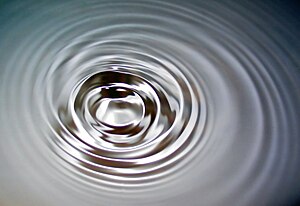
Wave
A wave is a disturbance that propagates through space and time, usually with transference of energy. A mechanical wave is a wave that propagates or travels through a medium due to the restoring forces it produces upon deformation. There also exist waves capable of traveling through a vacuum, including electromagnetic radiation and probably gravitational radiation. Waves travel and transfer energy from one point to another, often with no permanent displacement of the particles of the medium (that is, with little or no associated mass transport); they consist instead of oscillations or vibrations around almost fixed locations.Characteristics
Periodic waves are characterized by crests (highs) and troughs (lows), and may usually be categorized as either longitudinal or transverse. Transverse waves are those with vibrations perpendicular to the direction of the propagation of the wave; examples include waves on a string, and electromagnetic waves. Longitudinal waves are those with vibrations parallel to the direction of the propagation of the wave; examples include most sound waves.
When an object bobs up and down on a ripple in a pond, it experiences an orbital trajectory because ripples are not simple transverse sinusoidal waves.
Ripples on the surface of a pond are actually a combination of transverse and longitudinal waves; therefore, the points on the surface follow orbital paths.
All waves have common behavior under a number of standard situations. All waves can experience the following:
- Reflection — change in wave direction after it strikes a reflective surface, causing the angle the wave makes with the reflective surface in relation to a normal line to the surface to equal the angle the reflected wave makes with the same normal line
- Refraction — change in wave direction because of a change in the wave's speed from entering a new medium
- Diffraction — bending of waves as they interact with obstacles in their path, which is more pronounced for wavelengths on the order of the diffracting object size
- Interference — superposition of two waves that come into contact with each other (collide)
- Dispersion — wave splitting up by frequency
- Rectilinear propagation — the movement of light waves in a straight line also helpful for seismographs
Examples
- Ocean surface waves, which are perturbations that propagate through water
- Radio waves, microwaves, infrared rays, visible light, ultraviolet rays, x-rays, and gamma rays, which make up electromagnetic radiation; can be propagated without a medium, through vacuum; and travel at 299,792,458 m/s in a vacuum
- Sound — a mechanical wave that propagates through gases, liquids, solids and plasmas
- Waves of traffic, that is, propagation of different densities of motor vehicles, and so forth, which can be modeled as kinematic waves, as first presented by Sir M. J. Lighthill
- Seismic waves in earthquakes, of which there are three types, called S, P, and L
- Gravitational waves, which are nonlinear fluctuations in the curvature of spacetime predicted by General Relativity, but which have yet to be observed empirically
- Inertial waves, which occur in rotating fluids and are restored by the Coriolis effect
Standing wave

A standing wave, also known as a stationary wave, is a wave that remains in a constant position. This phenomenon can occur because the medium is moving in the opposite direction to the wave, or it can arise in a stationary medium as a result of interference between two waves traveling in opposite directions.
The sum of two counter-propagating waves (of equal amplitude and frequency) creates a standing wave. Standing waves commonly arise when a boundary blocks further propagation of the wave, thus causing wave reflection, and therefore introducing a counter-propagating wave. For example when a violin string is displaced, longitudinal waves propagate out to where the string is held in place at the bridge and the "nut", whereupon the waves are reflected back. At the bridge and nut, the two opposed waves are in antiphase and cancel each other, producing a node. Halfway between two nodes there is an antinode, where the two counter-propagating waves enhance each other maximally. There is on average no net propagation of energy.
Source: wikipedia
Video

Movie
click


Tidak ada komentar:
Posting Komentar